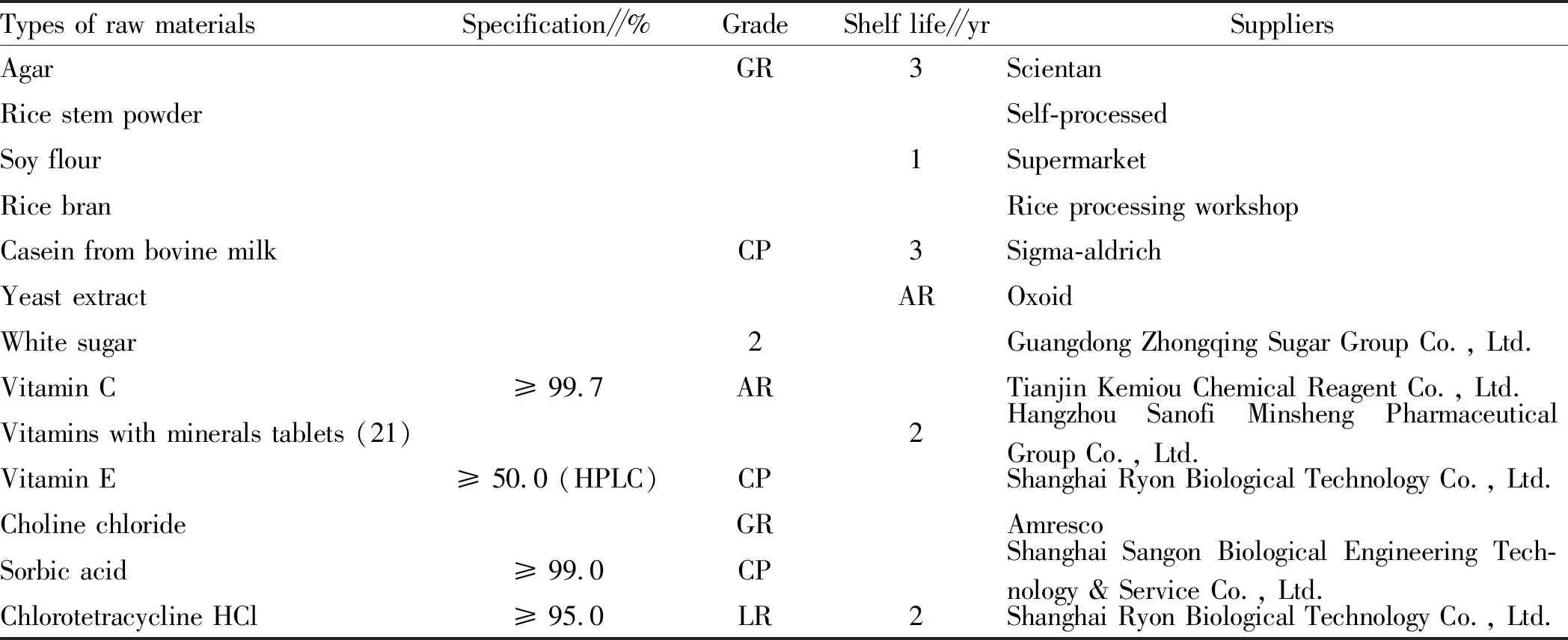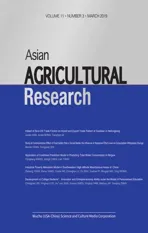Preliminary Study on Shelf Life of Artificial Feed of Chilo suppressalis
2019-04-25,,*
, , *
1. Changsha County Wangyue Park Management Office of Hunan Province, Changsha 410013, China; 2. Institute of Plant Protection, Guizhou Academy of Agricultural Sciences, Guiyang 550006, China
Abstract In order to preliminarily explore the preservation effect of ordinary refrigerator (4℃) on artificial diet of Chilo suppressalis, the effects of artificial feed preserved at refrigerator for different time on percentage of pupation and pupa weight of C. suppressalis were investigated to understand the impact of long-term storage of artificial feed on the growth and development of C. suppressalis. The results showed that the percentage of pupation of C. suppressalis fed with artificial diet that had been stored in refrigerator for 40 d (T40) was highest (67.1%), followed by CK (1 d, 63.5%), and the percentage of pupation of C. suppressalis fed with artificial diet that had been stored in refrigerator for 10 d (T10) was 61.9%. No significant difference was found in percentage of pupation among the treatment groups (P>0.05). The female pupa weight of the short-term preservation treatment group (71.9 mg) was significantly larger than that of the long-term preservation treatment group (66.1 mg) (P<0.05), and was insignificantly different from that of CK (P>0.05). The male pupa weight of the short-term preservation treatment group (51.2 mg) was significantly larger than that of CK (47.7 mg) (P<0.05), and the male pupa weight of the long-term preservation treatment group was slightly larger than that of CK (P>0.05). In conclusion, the artificial diet of C. suppressalis can be stored for at least 40 d in refrigerator (4℃).
Key words Chilo suppressalis, Artificial feed, Refrigeration, Shelf life
1 Introduction
Food has a shelf life. Excessive storage or improper storage can lead to food contamination or deterioration. In general, the longer the food is stored, the less its nutrition will be. At the same time, it may also breed harmful substances such as bacteria, which may have adverse effects on consumers[1-2]. The shelf life of food is mainly determined by the test method, the literature method and the reference method. The test method is to place food samples in an environment above normal levels to promote the deterioration of food samples, collect relevant test data on a regular basis, and estimate the shelf life of the food[3]. These standards are mainly for the food or food ingredients of humans or animals, and insect artificial feed is not involved.
Chilosuppressalis(walker) is an important pest of rice in China. It does harms throughout the year, seriously affecting rice production[4]. Indoor breeding ofC.suppressaliscan help to study its harmful mechanisms and drug resistance[5-6]. The formula and breeding technology of the artificial diet ofC.suppressalishas been very mature[7]. For example, the use of preservatives such as sorbic acid can extend the use time of artificial feed[8]. However, the shelf life of the artificial feed ofC.suppressalishas not been reported. The artificial feed required in the laboratory is generally formulated when needed. It is often feared that artificial feed stored for a long time may affect the growth and development of insects. To this end, the shelf life of artificial diet ofC.suppressaliswas studied to determine whether artificial feed stored for a long time has an effect on the growth and development ofC.suppressalisand provide a certain reference for the artificial breeding of other insects as well.
2 Materials and methods
2.1MaterialsChilosuppressalis(rice stem borer) was collected from the rice field of Huishui County, Guizhou Province in February 2016. The over-wintering larvae ofC.suppressaliswere taken back to the laboratory and fed with artificial diet. The test insects were the second generation of the rice stem borers raised indoors. There were 13 kinds of raw materials for the artificial diet ofC.suppressalis. The specific varieties, content and sources of the raw materials are shown in Table 1.
2.2FeedingenvironmentThe configuration of the larval chamber was as follows: temperature (25±1)℃, relative humidity (50±10)%, light period/dark period = 16 h/8 h, and artificial diet (feeding box 10 cm in diameter and 10 cm in height).
The configuration of adult worm room was as follows: daytime temperature (25±1)℃, day time relative humidity 60%-70%, night temperature (20±1)℃, night relative humidity 80%-90%, natural light, and feed of 10% honey water.
2.3MethodsA total of three treatments were arranged: long-term preservation (40 d), short-term preservation (10 d) and control (CK, 1d). That is, the artificial diet was prepared 40 d (T40), 10 d (T10) and 1 d (T1) before the first hatching of the larvae, and the artificial feed was sealed with plastic wrap and placed in a refrigerator at 4℃. Each treatment was repeated four times. The artificial feed preparation steps referred to the method of Hu Yangetal[9-10].
Table1Types,specification,shelflifeandsuppliersofrawmaterialsoftheartificialdietforChilosuppressalis

Types of raw materials Specification∥%GradeShelf life∥yrSuppliersAgarGR3ScientanRice stem powderSelf-processedSoy flour1SupermarketRice branRice processing workshopCasein from bovine milkCP3Sigma-aldrichYeast extractAROxoidWhite sugar2Guangdong Zhongqing Sugar Group Co., Ltd.Vitamin C≥ 99.7ARTianjin Kemiou Chemical Reagent Co., Ltd.Vitamins with minerals tablets (21)2Hangzhou Sanofi Minsheng Pharmaceutical Group Co., Ltd.Vitamin E≥ 50.0 (HPLC)CPShanghai Ryon Biological Technology Co., Ltd.Choline chlorideGRAmrescoSorbic acid≥ 99.0CPShanghai Sangon Biological Engineering Tech-nology & Service Co., Ltd.Chlorotetracycline HCl≥ 95.0LR2Shanghai Ryon Biological Technology Co., Ltd.
Note: GR, guaranteed reagent; AR, analytical reagent; CP, chemical pure; LR, laboratory reagent; HPLC, high performance liquid chromatography.
A total of 100 newly hatched larvae were prepared for each treatment. After 30 d, the larvae in each treatment were fed with corresponding artificial feed. The pupation rings were placed for the pupation of mature larvae and replacement of feed. After 7 d, the pupation rings were replaced once. After stood for 2 d, the removed pupation rings were peeled off and the pupae in them were taken out. The male and female pupae were placed in separate dishes. The number and weight of males and females in each treatment were recorded, and the pupation rate was calculated.
2.4DataprocessingThe same indicator data between different treatments was analyzed by DPS 9.50 data processing system. The significant difference test between treatments was performed using Duncan’s new multiple range method.
3 Results and analysis
As shown in Table 2, the artificial feed stored for a long time had little effect on the growth and development ofC.suppressalis. Among different groups, the pupation rate ranked as T40 (67.1%) > CK (63.5%) > T10 (61.9%), but there is no significant difference between them. The development duration of male and female larvae and pupae in the T10 treatment group was all shorter than that of CK; while the development duration of female larvae and pupae was shorter and the development duration of male larvae and pupae was longer in the T40 treatment group compared with that in the CK (P>0.05). The female pupa weight of T10 treatment group (71.9 mg) was significantly higher than that of T40 (66.1 mg) (P<0.05), but showed no significant difference when compared with CK. The male pupa weight of T10 (51.2 mg,P<0.05) and T40 (49.1 mg,P>0.05) treatment groups was greater than that of CK (49.1 mg). In summary, the artificial diet ofC.suppressaliscan be stored for at least 40 d in the refrigerator (4℃).
Table2EffectsofartificialfeedpreservedfordifferenttimeonthegrowthanddevelopmentofChilosuppressalis

TreatmentDuration of larval + pupal stages∥d♀♂Pupal weight∥mg♀♂Pupation rateT1(CK)43.2±0.5 a40.6±0.3 a69.2±1.6 ab47.7±0.9 b63.5±2.1 aT1042.7±0.5 a40.3±0.5 a71.9±1.3 a51.2±0.9 a61.9±3.1 aT4042.3±0.4 a40.8±0.3 a66.1±1.3 b49.1±0.8 ab67.1±3.5 a
Note: Date in the table are mean ± SE. Different letters in the same column indicate significant difference atP<0.05 level by Duncan’s new multiple range test.
4 Discussion
The shelf life of food is related to the characteristics of the food itself, the processing method, the packaging method and the amount of preservatives[11-12]. The raw material for the artificial diet ofC.suppressaliswas composed of milled powder of dry matter (56.5%), chemical reagents (41.0%) and preservative (2.5%). Among them, chemical reagents are not easily deteriorated (shelf life 2-3 years). The milled powder of dry matter can usually be stored at room temperature for about one year. In addition, feed shelf life can also be extended by the addition of preservatives[13]. Therefore, artificial feed may be stored for a longer period of time when refrigerated at low temperature. This study found that long-term preservation (40 d) of artificial feed had no significant effect on the growth and development ofC.suppressalis. Therefore, the artificial diet ofC.suppressaliscan be stored for at least 40 d in a refrigerator (4℃). It is recommended to mix more at a time when preparing the artificial diet ofC.suppressalis. This can save time. If there is any remaining feed, it is no rushed to throw it away. Instead, it can be stored in the refrigerator (at least 40 d) for use.
杂志排行
Asian Agricultural Research的其它文章
- Establishment and Optimization of Two-dimensional Electrophoresis System for Spleen Proteome of Sillago sihama Forsskål
- Breeding of a New Tussah Variety "Gaoyou 1"
- Study of the Discount on Private Placements and Risk of Stock Market Crash in Listed Companies
- Investigation and Analysis on Diversity of Lucanidae spp. in Fanjing Mountain National Nature Reserve
- Spatio-temporal Variability of Disastrous Convective Weather in China from 1961 to 2016
- Impact of Sino-US Trade Friction on Import and Export Trade Pattern of Soybean in Heilongjiang
